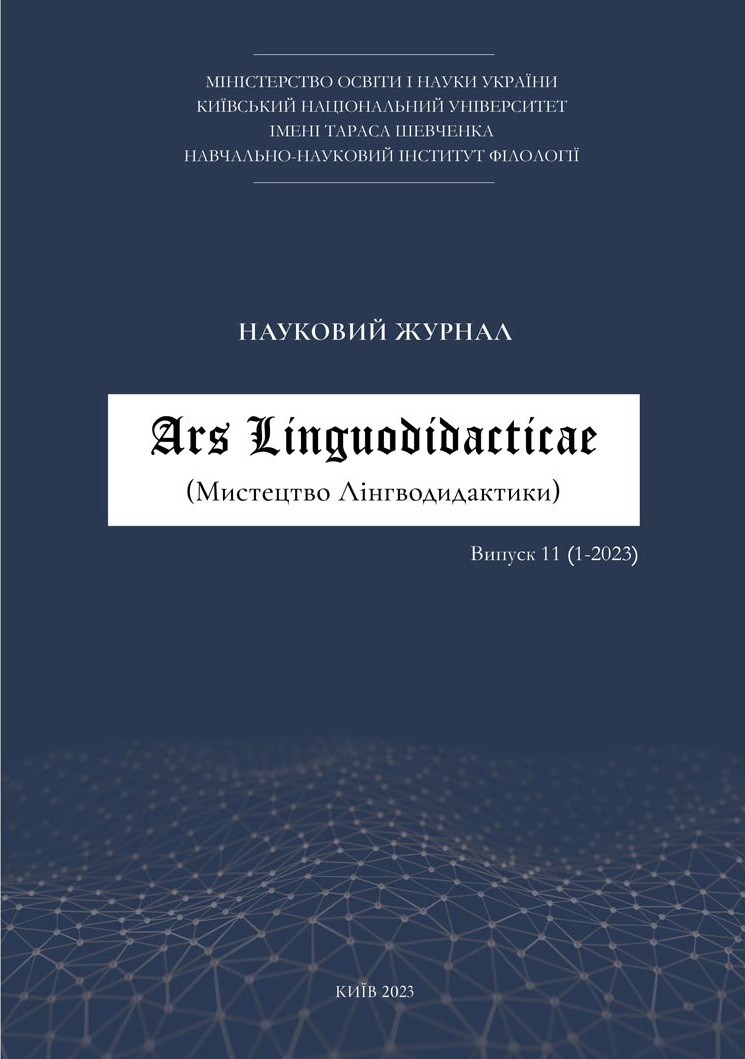ЗМІШАНЕ НАВЧАННЯ УСНОГО АНГЛІЙСЬКОГО МОВЛЕННЯ СТУДЕНТІВ- ФОЛЬКЛОРИСТІВ З ВИКОРИСТАННЯМ ТЕХНОЛОГІЇ «ПЕРЕВЕРНУТИЙ КЛАС»
DOI:
https://doi.org/10.17721/2663-0303.2023.1.04Ключові слова:
змішане навчання, технологія «Перевернутий клас», усне англійське мовлення, студенти-фольклористиАнотація
Статтю присвячено дослідженню змісту і форм змішаного навчання усного англійського мовлення студентів, які опановують фах фольклористики. В основу навчання покладено технологію «Перевернутий клас». Автори зосереджують увагу на збалансованих частках аудиторної і самостійної роботи студентів освітнього рівня «Бакалавр» в опануванні усного англійського мовлення: аудіювання і говоріння. Комплекс вправ і завдань з англійської мови орієнтовано на фахові зацікавлення студентів-фольклористів. У статті доведено ефективний вплив змішаного навчання за технологією «Перевернутий клас» на усномовленнєву англійську компетентність студентів. Зокрема результатом навчання стали розвинені уміння: аудіювати автентичні тексти за фахом; самостійно добирати матеріали для аудіювання, які відповідають тематиці фольклористичних дисциплін та рівню навченості студента; використовувати прийоми навчання аудіювання, зручні для самостійної роботи; говорити у формах діалогу та монологу на теми, пов’язані із фахом фольклориста.
Посилання
Banditvilai, C. (2016). Enhancing students’ language skills through blended learning. Electronic Journal of e-Learning, 14 (3), 220–229.
Bezliudna, V., & Svyrydyuk, O. (2023). Praktyka zmishanoho navchannya pry vykladanni inozemnoyi movy u ZVO Velykobrytaniyi [Blended learning practice in teaching foreign languages in UK higher education institutions]. International Science Journal of Education & Linguistics, 1, 86-92. In Ukr.
Bezliudnyi, O., Bezliudna, V., Shcherban, I., & Komar O. (2019). Dosvid vykorystannya zmishanoho navchannya na zanyattyakh z anhliyskoyi movy u zakladakh vyshchoyi pedahohichnoyi osvity [Experience of using blended learning in English language classes in higher education pedagogical institutions]. Information Technologies and Learning Tools, 73, 86-100. In Ukr.
Dybska, T. (2020). Metodyka zmishanoho navchannya usnoho yaponskoho movlennya maybutnikh filolohiv. [Blended learning methodology for Japanese oral production development in future philologists] [PhD thesis]. Taras Shevchenko National University of Kyiv. In Ukr.
Gruber, A. (2018). Blended Language learning in higher education: Students’ and tutors’ perceptions and experiences. Innovation in Language Learning: International Conference paper, 1-5. https://bit.ly/3XzYas9
Konoplianyk, L., & Melnykova, K. (2019).Vykorystannya tekhnolohiyi «Perevernutyy klas» pry navchanni fakhovoyi inozemnoyi movy [Utilizing the «Flipped Classroom» technology in teaching a foreign language for specific purposes]. https://bit.ly/3NZbBhU. Bulletin of the National Aviation University. Series: Pedagogy. Psychology, 2(15), 38-45. In Ukr.
Kuzminska, O. (2016). Perevernute navchannya: praktychnyy aspekt [Flipped learning: practical aspect]. Informatsiyni Tekhnolohiyi v Osviti, 1, 86-98. In Ukr.
Nikolayeva, S. (Ed.). (2013). Metodyka navchannya inozemnykh mov i kultur: teoriya i praktyka Методика навчання іноземних мов і культур: теорія і практика [Teaching foreign languages and cultures: theory and practice]. Textbook. Lenvit. In Ukr.
Noskova, M., & Shuplat, A. (2018). Vprovadzhennya elementiv zmishanoho navchannya u protsesi navchannya anhliyskoyi movy u zakladi zahalnoyi serednoyi osvity [Implementation of blended learning elements in the process of teaching English language in a secondary education institution]. Pedahohika Formuvannya Tvorchoyi Osobystosti u Vyshchiy i Zahalnoosvitniy Shkolakh, 61 (1), 90-94. In Ukr.
Popadyuk, S., & Skurativska, M. (2017). Metodolohichni zasady vykorystannya osvitnoyi kontseptsiyi «perevernute navchannya u vyshchiy shkoli» [Methodological foundations of using the educational concept of «Flipped Learning in Higher Education»]. Pedahohichni Nauky, 76 (3), 149-154. In Ukr.
Prykhodkina, N. (2014). Vykorystannya tekhnolohiyi «perevernenoho navchannya» u profesiyniy diyalʹnosti vykladachiv vyshchoyi shkoly [Utilizing the «Flipped Learning» technology in the professional activities of higher education instructors]. Naukovyy Visnyk Uzhhorodskoho Natsionalnoho Universytetu. Seriya «Pedahohika. Sotsialna Robota», 30, 141-144. In Ukr.
Sari R., Evianty R., & Amran М. (2019). Listening skills for learning German using blended learning models. Budapest International Research and Critics in Linguistics and Education (BirLE) Journal, 2, 616-621.
Shchehlova, A. (2016). Mistse proektnoho metodu dlya formuvannya i rozvytku inshomovnoyi komunikatyvnoyi kompetentnosti studentiv v umovakh zmishanoho navchannya [The role of project-based methodology in shaping and developing students’ foreign language communicative competence in the context of blended learning]. Informatsiyni Tekhnolohiyi i Zasoby Navchannya, 3 (53), 142. In Ukr.
TED-Ed. (2016, October 24). Why should you listen to Vivaldi’s «Four Seasons»? – Betsy Schwarm. [Video]. YouTube. https://www.youtube.com/watch?v=Xcpc8VDsv3c
TED-ED. (2016a, November, 22). The secrets of Mozart’s «magic flute»- Joshua Borths. [Video]. YouTube. https://www.youtube.com/watch?v=8iKd-P4Bcac
TED-Ed. (2021, September 21). The Secrets of the world’s most famous symphony – Hanako Sawada. [Video]. YouTube. https://www.youtube.com/watch?v=7n0tNSFJQ34&t=79s
TED-Ed. (2023, June 1). Test yourself: Can you tell the difference between music and noise? – Hanako Sawada [Video]. YouTube. https://youtu.be/UsY-WfoKy80
##submission.downloads##
Опубліковано
Як цитувати
Номер
Розділ
Ліцензія

Ця робота ліцензується відповідно до Creative Commons Attribution-NonCommercial 4.0 International License.
Ця робота ліцензується відповідно до Creative Commons Attribution-NonCommercial 4.0 International License.
Політика охорони авторських прав відповідно до умов ліцензії: Creative Commons Attribution-NonCommercial (Атрибуція-Некомерційне використання) 4.0 Міжнародна (CC BY-NC 4.0).
Автори, що публікують свої статті в журналі "Ars Linguodidacticae" (журналі відкритого доступу) зберігають за собою такі права:
- Автори зберігають за собою права на авторство своєї статті та надають журналу "Ars Linguodidacticae" право першої публікації рукопису своєї статті на умовах ліцензії Creative Commons (CC BY-NC 4.0) Attribution License, яка дозволяє іншим особам вільно розповсюджувати опубліковану роботу з обов'язковим посиланням на автора оригінальної роботи та першу оригінальну публікацію в журналі "Ars Linguodidacticae". Інформація про збереження права на авторство надається на титульній сторінці статті.
- Автори зберігають за собою право укладати окремі угоди на неексклюзивне розповсюдження своєї статті у тому вигляді, в якому вона була опублікована в журналі "Ars Linguodidacticae" (наприклад, розміщувати статтю в електронних бібліотеках, архівах та каталогах або публікувати у складі інститутських збірників та монографій), за умови обов'язкового повного посилання на першу оригінальну публікацію в журналі "Ars Linguodidacticae".
- Політика журналу "Ars Linguodidacticae" дає змогу та заохочує розміщення авторами в мережі Інтернет (наприклад в інститутському репозитарії або на персональному сайті) рукопису роботи як до її подання до редакції, так і під час її редакційного опрацювання, оскільки це сприяє продуктивній науковій дискусії та позитивно позначається на оперативності й динаміці цитування статті.
Редакція журналу зберігає за собою видавничі права на:
- зверстані оригінали статей та весь номер журналу;
- оформлення журналу, а також оригінальні ілюстративні та додаткові матеріали;
- репринтні перевидання журналу в друкованому та електронному вигляді.
Політика охорони авторських прав провадиться відповідно до умов ліцензії: Creative Commons Attribution-NonCommercial (Атрибуція-Некомерційне використання) 4.0 Міжнародна (CC BY-NC 4.0).
Для отримання додаткової інформації, будь ласка, прочитайте повний текст Публічної ліцензії CC BY-NC 4.0
Creative Commons Attribution-NonCommercial 4.0 International License.

